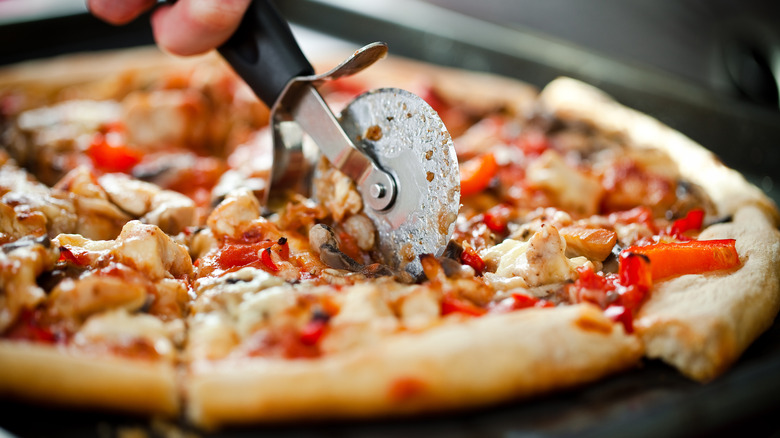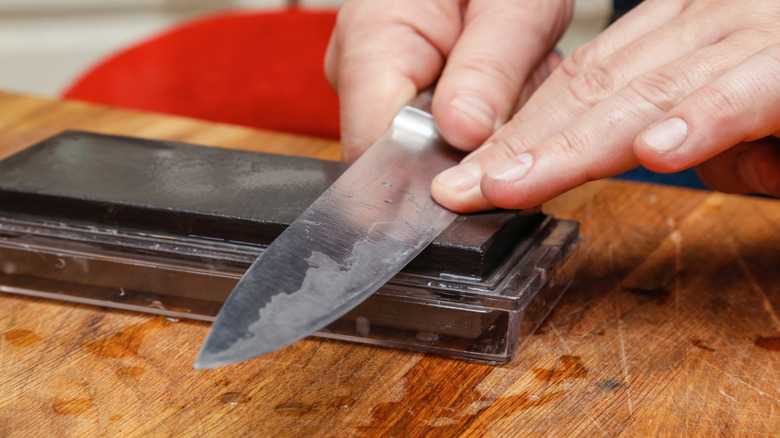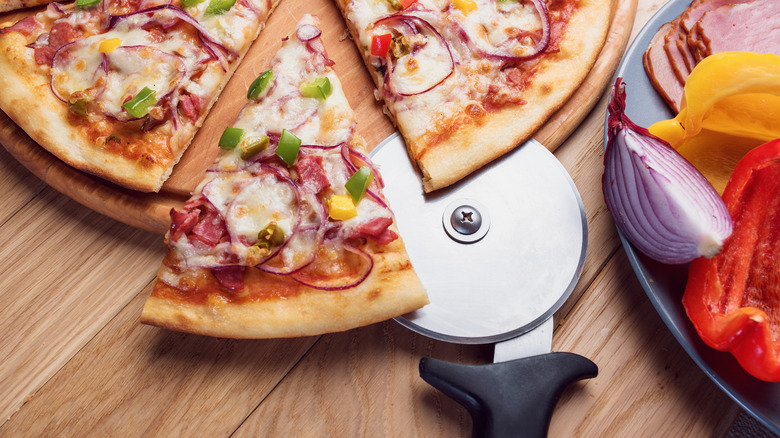How To Sharpen A Pizza Cutter Without A Trip To The E.R.
Although plenty of things can go wrong while you're slicing up a pizza, perhaps the biggest pizza-cutting mistake you're making is not using a sharp enough utensil. A dull pizza cutter will tear your pizza rather than cleanly cut it, giving your arm a full workout in the process. Dulling of the blade can happen in any number of ways, be it improper use, cutting on a pizza stone, or storing in a drawer full of other metal utensils.
As such, it's important to properly care for a pizza cutter or, at the very least, know how to sharpen one. That being said, some sharpening methods are more dangerous than others, so let's address the safest one first: a specialized pizza cutter sharpener. One version of this tool includes a non-stick base that you place on a counter or table. To use, simply roll the pizza cutter through the sharpener as you would through a pizza, allowing the sharpener's internal mechanisms to file all angles of the blade. The best part of this tool is that it doesn't require you to hold the blade still (risking injury) as you manually sharpen it.
Less ideal ways to sharpen a pizza cutter
If you don't own a pizza cutter sharpener, the most similar tool is a knife sharpener. However, you'll need to make sure that the pizza cutter's blade actually fits in the sharpener. You'll also need to hold the blade in place to keep it from spinning, which can prove dangerous. Alternatively, you could use a whetstone or its smaller, handheld cousin, the puck sharpener. Both should be soaked in water for up to 15 minutes before you manually sharpen your pizza cutter against the stone's rough surface. Again, these two tools can lead to injury, as you may cut yourself as you hold the pizza cutter's blade steady.
Another method calls for access to a belt grinder, which is commonly used in metalwork. This might just be the most dangerous option, as you must hold your pizza cutter in place, keep your hands out of the grinder's path, and wear various protective gear (such as glasses and a mask) to safeguard against airborne debris. Seriously, don't use this method if you can avoid it.
Minimize the need for sharpening with proper pizza cutter care
We're not saying that taking perfect care of your pizza cutter means you'll never have to sharpen the blade, but it can certainly help your blade last a lot longer. Such care includes cleaning your pizza cutter immediately after use before the cheese and sauce have had time to harden on the blade. Though you may soak a pizza cutter to help remove stubborn food, you should never soak for too long, as prolonged exposure to water can cause the blade to rust. Avoid the dishwasher since its abrasive washing can also dull the pizza cutter's blade.
When it comes to safely storing your pizza cutter, do so in the same way you might store knives. In other words, don't toss it into a drawer, where the blade can be damaged by other utensils or potentially injure someone reaching in. Instead, protect the blade and yourself by storing it on a magnetic knife bar or with some sort of cover — a box, a sponge with a slot cut into it, even candle putty.



